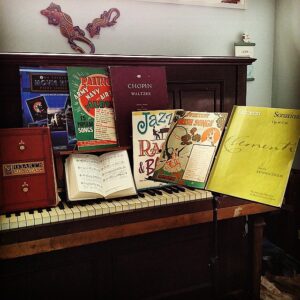Practising your Musical Instrument
If you are learning an instrument you get the most out of lessons if you are practising at home between lessons. Therefore, it is advisable to have the instrument and the music so you can do this.
You have to decide what is the purpose of learning an instrument. Is it to play for fun and relaxation at home or something else? Do you want to get to a performance level for a practical examination or to play at a concert?
Practise and play your musical instrument at home the techniques set from the lessons and anything else you want to, whether it is from other sheet music or creating your own tunes with improvisation or composition.
Read the following to learn how to practise your musical instrument so that you to get pieces to a performance level you desire.
How To Practise
Practising is the art of focused, repeated, playing. It is likened to the training a sports person does to be good. A coach or music teacher explains what the problems are and the real work is done by you at your training or practise sessions.
All You Need To Do Is Remember the words
P R A C T I S E L O T S
PRACTISE LOTS
in slightly more detail with a word or words from each letter
P lay
R epeat Often
A ct Upon
C arefully
T unefully
I n Time
S lowly
E venly
L isten To
O thers
T hat
S hine
In More Detail Again
P lay
Playing your instrument between lessons will help the learning process.
1. Do focussed playing:
Focussed playing means playing mindfully. Listen carefully and aim towards an outcome you are happy with.
The amount of time for your focussed practise will vary, depending on your experience and goals. If you are a more experienced player you are, then you are more likely to have more repetoire to play and hence more time required to practise.
Use the following as a guideline only.
Beginners can start off with 5-10 minutes.
Intermediate players (at grade 5 level) should expect to play for at least 30 minutes
Advanced players (grade 8 and above) may practise 2 or 3 hours. Regular training works.
Just remember the whole point of learning an instrument is to enjoy it. Always play music you like for fun as well as your focused practise sessions for improvement. Gradually the more difficult pieces will become easier and greafor fun.
2. Play extra exercises:
If there are problems in any section of the piece then you can do extra exercises or games away from the piece eg in rhythm, tone, accuracy of notes.
For instance, rhythm exercises on rhythms you find difficult could include clapping and counting out loud, slowly and playing it several times. A metronome can keep you in time, especially if you play a wind instrument and can’t count out loud when you play.
You can then go back to the section(s) in the piece and play it several times.
R epeat Often
It is better to do lots of little amounts of playing eg 5 – 10 minutes, on different days of the week, than one big play between lessons.
This is like anything in life, if you repeat it often enough then you get to know it. Draw yourself up a practise honesty chart with weeks down left-hand side and days of week across the top. Fill it in every time you practise. Try and do at least 5 practise sessions each week.
You can pull out the harder sections and repeat them more.
This could be two notes, such as an interval change for sound, or two bars to practise a difficult rhythm.
Then practise a couple of bars or a phrase either side of the difficult section(s) to flow it through. Extend the number of phrases you practise around the difficult part(s) and eventually play the whole piece through at the speed of the difficult section(s).
Sometimes people practise the difficult section on its own and get it correct and then when it is put in context with more of the piece, the original mistake reoccurs. This is common. Just keep up the slow, focused practise to make easier. And it will become as easy as the rest of the piece.
Practising difficult sections on their own help make the sections as easy as the simpler parts. Sometimes when there are easy and difficult sections people play them at different speeds and then do not get the understanding of how the piece should flow at one even tempo. This is where you play the piece at the speed of the harder sections. Use an external beat like a metronome to help you.
A ct
Don’t Procrastinate.
Take Action and Apply Techniques Learned
C arefully
It is best not to rush your playing, as this tends to create mistakes. Take the time to understand everything you have learned, like note lengths, rhythms, how to play the notes on your instrument, correct posture, addition of musical features like dynamics, accents, getting slower or faster.
T unefully
Use your ears to listen for notes not sounding as you would like.
I n Time
Ways to help keep in time are to
- write the counts underneath the music
- count out loud if you can or tap your foot whilst playing
- listen to someone else play especially the trickier bits
- play with someone else.
A good process to follow is to clap and count or play notes and count.
S lowly
This enables you to focus on all areas of the piece and get it accurate eg note lengths and rhythm, pitch and sounds on instrument, flow going from start to finish and more. If the piece needs to go at a fast pace then you will need to do lots of repeated playing to build up the speed with ease. Lots of slow, focused practise will aid with this.
E venly
Make sure you count a steady beat throughout eg 1 2 3 4 1 2 3 4 1 2 3 4 etc. Do not rush your counting especially on the easier sections. Think of marching girls or dancers, who have to move to music at an even steady speed.
L isten to
It is a great help to hear good musicians play.
O thers
Find a recording of the piece you are working on from an expert on your instrument eg CD, DVD or on You Tube
T hat
Follow your part and listen carefully.
S hine
Listening to others could help inspire you to play your instrument lots in order to keep your notes correct.
An example of a 30 minute practise session
Suitable for intermediate students. You can take a break in the middle if you want. Make sure the chair is at a comfortable height and you wear comfortable clothing.
~ no time limit: warm up or warm down or both with pieces you like to play
~ 5-10 minutes on current scales and technical exercises
~ 5-10 minutes on current studies, repeating some old ones
~ 15 minutes on the pieces you are currently learning
~ Additionally play your chosen material until finished eg entire pieces and scales. This will give you an update of your improvement. Be careful not to play the piece too fast. Keep the speed at the easy level you are at in your practise.
Practising an instrument is an Art
You need to
Play Your Instrument
to master technique(s)
and hence have fun and enjoyment
playing your favourite pieces
What Are Your Favourite Pieces?
Movie Themes? Army Music? Chopin Waltzes? Mozart Sonatas? Hymns? Jazz? Irish Music? Clementi Sonatinas? Or Something Else?
Go Forth and Enjoy Your Instrument.
Remember to *** P R A C T I S E L O T S *** to reap the benefits.
Learning an instrument stimulates the brain and hence benefits many areas of life.
If you have any questions please contact me here.

